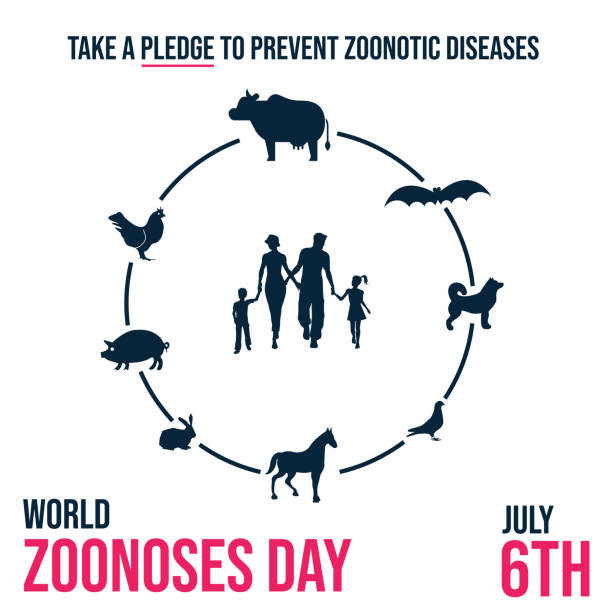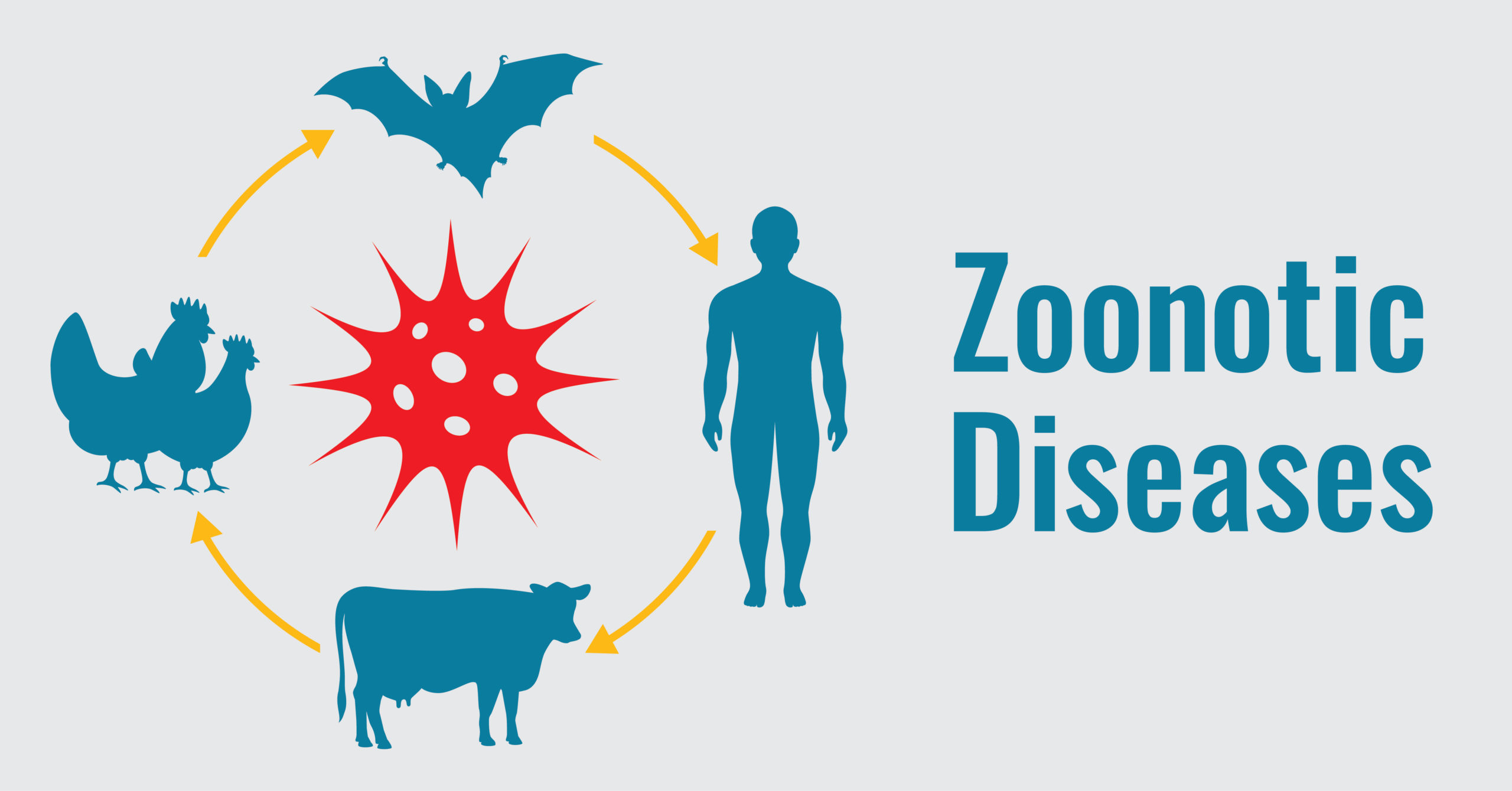Another name for a zoonotic disease is zoonosis. This type of disease passes from an animal or insect to a human. There are some that will sicken a human but not the animal.
Zoonotic disease can range from a small, short-lived illness to a serious, life-altering illness. Some of them have the potential to be fatal. Millions of people died from zoonotic diseases such bovine tuberculosis, the bubonic plague, and glanders prior to the advent of stricter hygiene rules about 100 years ago. In underdeveloped nations, they continue to be a big problem.
Types of Zoonotic Diseases
There are various zoonotic diseases, including those brought on by a virus, bacterium, fungus, and parasites, some of the most dangerous of these infections are those spread by ticks and mosquitoes. Examples of zoonotic diseases include;
- Animal flu
- Anthrax
- Bird flu
- Bovine tuberculosis
- Brucellosis
- Campylobacter infection
- Cat scratch fever
- Cryptosporidiosis
- Cysticercosis
- Dengue fever
- Ebola
- Encephalitis from ticks
- Enzootic abortion
- Erysipeloid
- Fish tank granuloma
- Giardiasis
- Glanders
- Hemorrhagic colitis
- Hepatitis E
- Hydatid disease
- Leptospirosis
- Listeria infection
- Louping ill
- Lyme disease
- Lymphocytic choriomeningitis
- Malaria
- Orf infection
- Parrot fever
- Pasteurellosis
- Plague
- Q fever
- Rabies
- Rat-bite fever
- Ringworm
- Rocky Mountain spotted fever
- Salmonella and E. coli infections
- Streptococcal sepsis
- Swine flu
- Toxocariasis
- Toxoplasmosis
- Trichinellosis
- Tularemia
- West Nile virus
- Zoonotic diphtheria
Mode of Transmission
There are numerous ways that zoonotic illnesses can spread from animals to humans including:
Direct Contact
One possible way that zoonotic infections can spread is through direct touch. These refers to coming into contact with bodily fluids such as saliva, blood, urine, mucus, or excrement from an infected animal. Simply handling or caressing sick animals, as well as being bitten or scratched by them, might result to zoonotic infection. Manure-contaminated water sources may also include a wide range of zoonotic bacteria, which raises the possibility that such bacteria could spread to people.
Indirect contact
Being in a location where infected animals reside or prowl, or touching a surface that has been polluted by an infected animal, constitutes indirect contact. Areas where this frequently happens include:
- Ponds with aquariums
- Chicken coops
- Pet kennels, baskets, or cages
- Plates for pet food and water
- Vegetation and soil contaminated by sick animals
Veterinarians, farmers, people who work in zoos or pet stores, and those who work in abattoirs are more likely to come into contact with zoonotic diseases. They may also contract the diseases and spread them to others by becoming carriers.
Food-borne
Contaminated animal food products, careless food handling, or insufficient cooking can all result in zoonosis. The following are typical food-borne zoonosis causes:
- Raw fruit and vegetables contaminated with feces from an infected animal
- Unpasteurized milk
- Undercooked meat or eggs
Vector-borne
A biological organism known as a “vector” is one that spreads an infection from an animal to a person or another animal, the zoonotic disease will be transmitted to humans once the vector bites an affected animal. The vectors are frequently arthropods. Some typical vectors are:
- Mosquitoes
- Fleas
- Lice
- Ticks
If you have a Zoonotic Disease, What should you do?
You should get medical attention right away if you have or suspect that you have a zoonotic disease. Make careful to take the animal to a veterinarian right away if it bites or scratches you. This is done to make sure they are properly immunized and free of rabies and other zoonotic diseases.
If a tick has bitten you, attempt to keep the tick after it has been removed in a secure container. This allows for the identification of the organism and the subsequent testing for any potential diseases that it may spread.
Even while zoonotic diseases are widespread, some humans are more susceptible to contracting them. Additionally, the reactions and symptoms in these people may be more severe. If you believe you may have a zoonotic disease and you fall into one of these categories of people at risk, you should seek medical care right once. Some people at high risk are:
- Those with HIV
- Others with weakened immune systems
- Adults aged 65 or older
- Children 5 years old or younger
- Pregnant women
- Those with cancer who are going through chemotherapy
Suggestions on how to Prevent Zoonotic Diseases
There are measures to guard against contracting a zoonotic disease. They include the following:
- Carefully wash your hands.
- Use insect repellent or other preventative measures to keep ticks, fleas, and mosquitoes at bay.
- Practice handling food safely.
- Steer clear of getting bitten or scratched by animals.
- Get your pets vaccinated, and take them to the vet on a regular basis every year.
- Consult your veterinarian for advice on the best flea and tick prevention for your dogs.
- While handling or being in close proximity to animals, refrain from eating, drinking, or touching your eyes or lips.
- If you need to handle an animal that is or seems sick, put on gloves.

Outlook
Depending on the ailment you have, different zoonotic diseases have different severity levels and prognoses. Many are curable, while others can result in catastrophic long-term, sometimes fatal, diseases. So it’s vital that you consult a physician or other healthcare provider as soon as you suspect you may have a zoonotic disease. Additionally, always exercise caution near all animals, domestic or wild.
